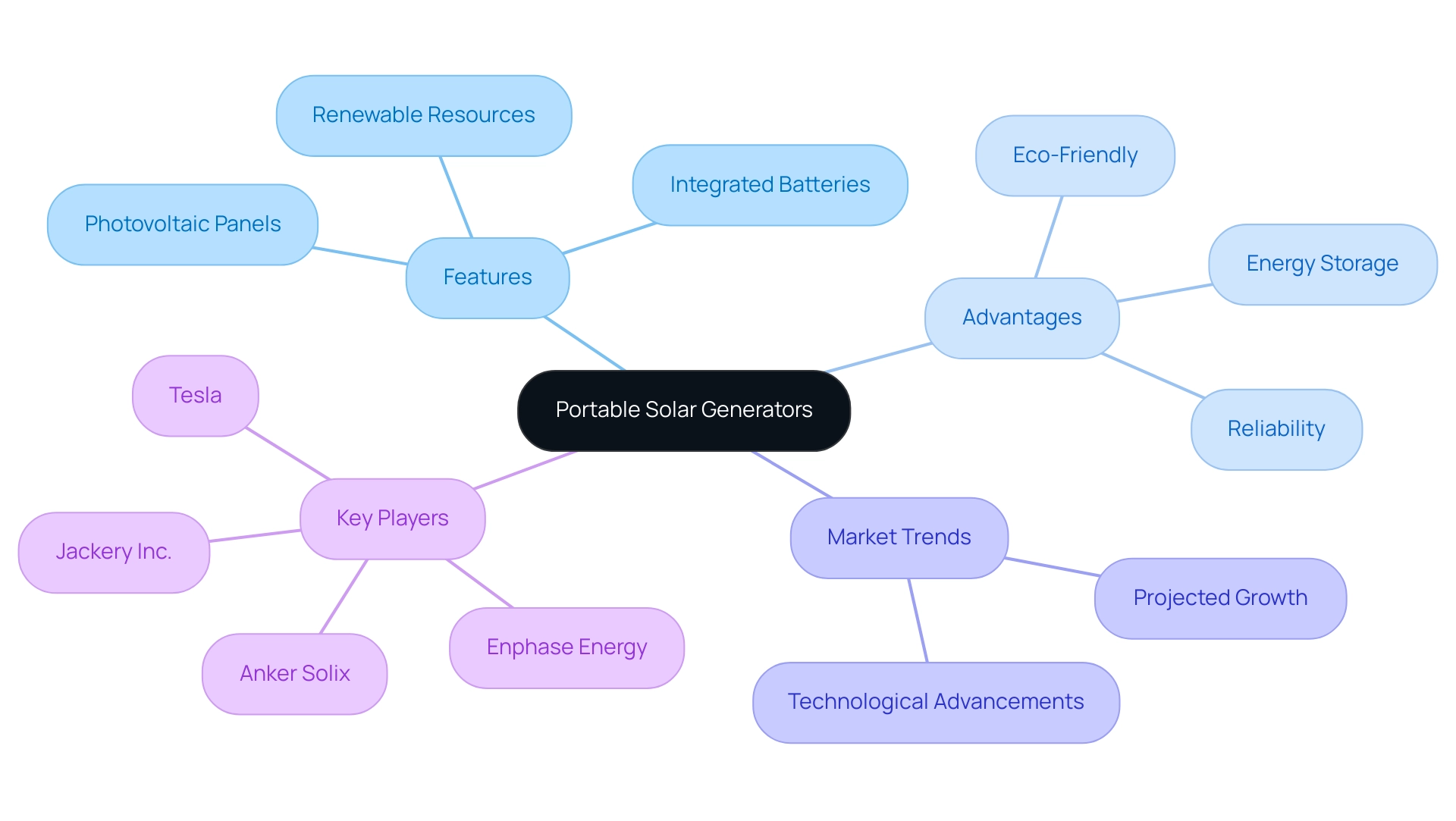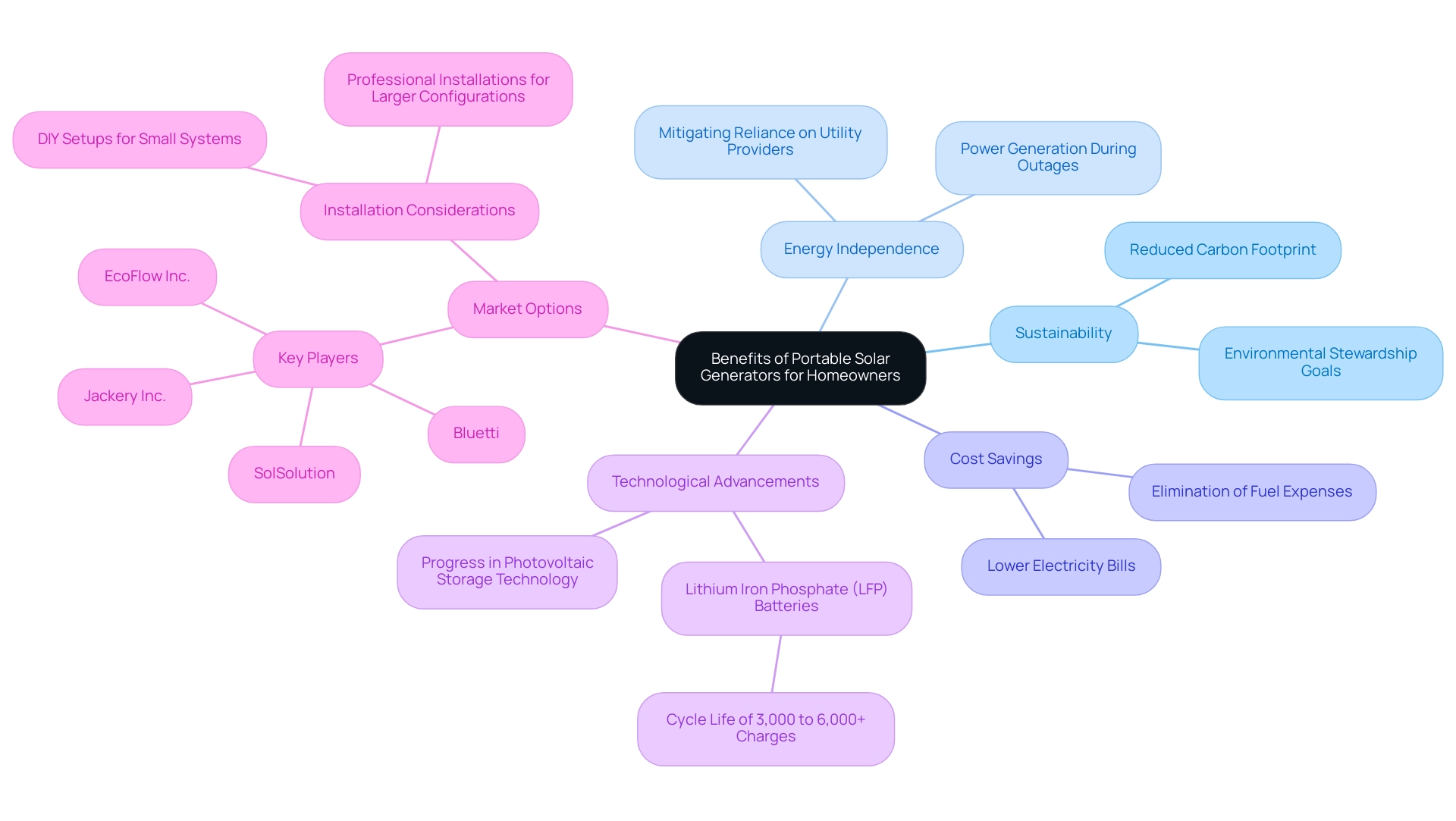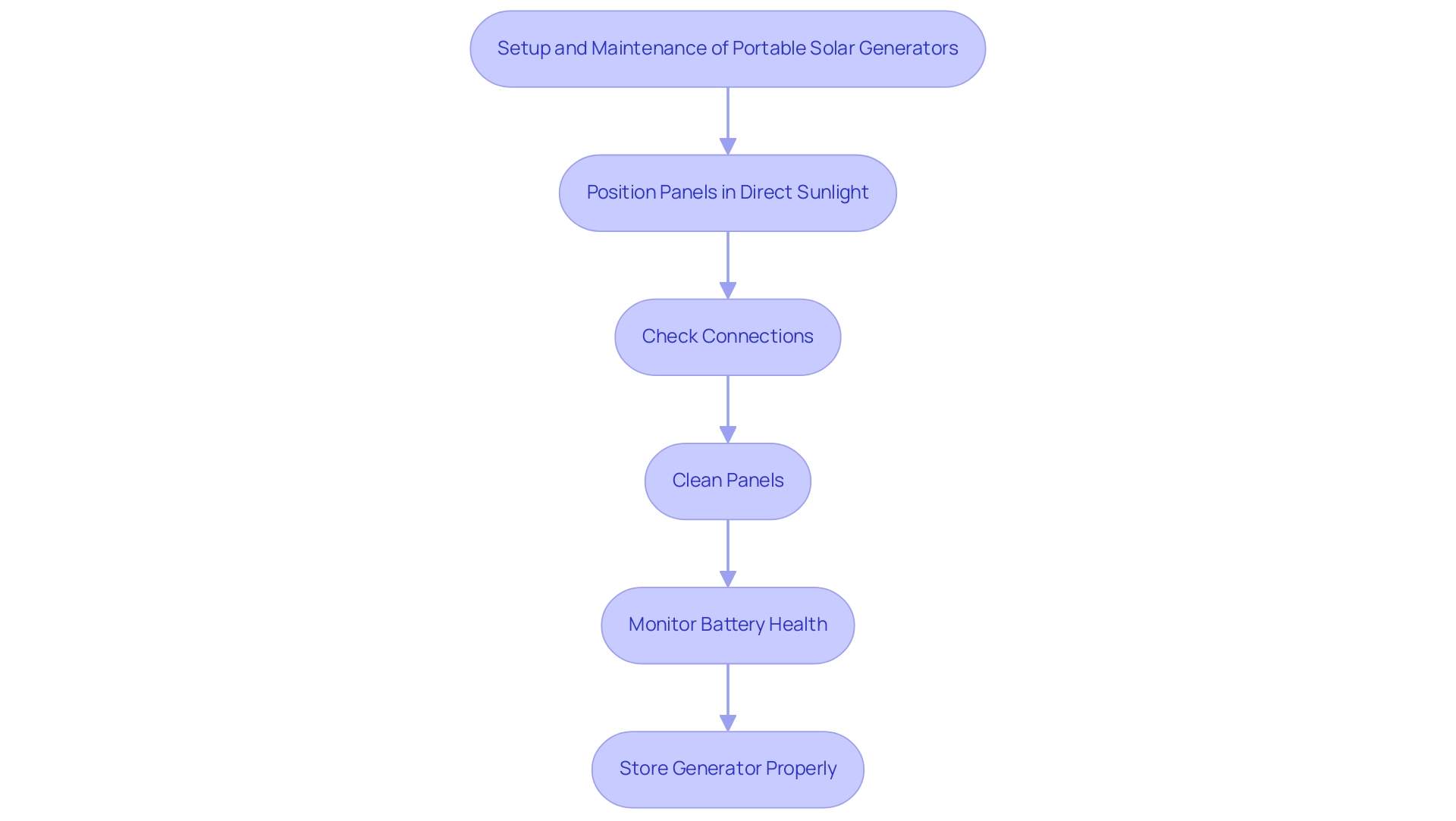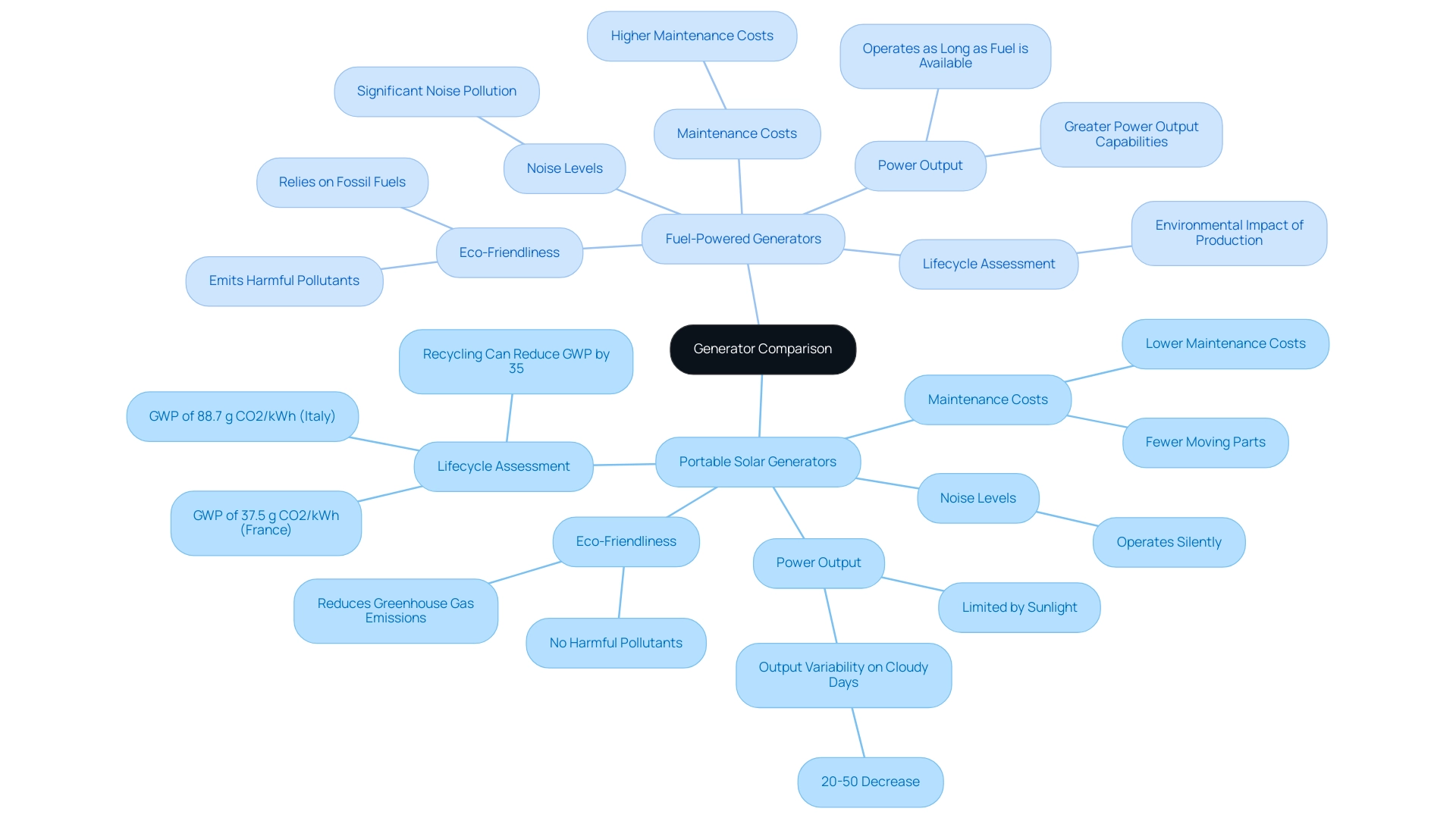Overview
A portable solar generator for house use is a compact and eco-friendly device that converts sunlight into electricity, providing a reliable power source for homeowners, particularly during outages or off-grid situations. The article explains that these generators not only reduce carbon footprints through renewable energy utilization but also offer long-term cost savings by lowering electricity bills and eliminating fuel expenses, making them a practical choice for environmentally conscious individuals.
Introduction
As the world shifts towards sustainable energy solutions, portable solar generators are emerging as a game-changer for eco-conscious homeowners. These compact devices harness the power of the sun, offering a clean and renewable alternative to traditional fuel-powered generators.
With advancements in technology, they not only provide reliable electricity during outages but also empower users to reduce their carbon footprints and embrace energy independence.
As the market for solar generators expands, understanding their benefits, limitations, practical applications, and cost considerations becomes essential for making informed decisions. This exploration delves into the multifaceted advantages of portable solar generators, highlighting their role in modern energy strategies and the growing trend towards sustainability in everyday life.
Defining Portable Solar Generators: An Overview
A portable sunlight power source is a versatile and compact device designed to capture light through photovoltaic panels, converting it into usable electricity. Unlike traditional machines that rely on fossil fuels, these innovative systems, including a portable solar generator for house, harness renewable resources, establishing themselves as eco-friendly options for homeowners. Typically featuring integrated batteries with varying capacities and power ratings, a portable solar generator for house stores energy for later use, ensuring a reliable power source during outages or while off the grid.
This flexibility is becoming more attractive, particularly as the renewable energy device market is anticipated to expand considerably from 2024 onwards, with a projected growth in market size by XX% (insert specific statistic from the Electric Generator Market Size & Share report here). Key players like Jackery Inc and Anker Solix are pioneering advancements in this sector. Anker Solix, for example, is establishing a niche with its incorporation of renewable energy technology into portable charging solutions, enhancing usability for consumers.
Additional advancements from firms like Tesla and Enphase Energy highlight the trend towards enhanced efficiency and cost-effectiveness in renewable energy technology. Additionally, the significance of battery backups cannot be overstated, as they provide essential reliability during power outages and adverse weather conditions. This advancement not only aids in enhancing panel output but also tackles the essential demand for sustainable power solutions, making a portable solar generator for house a practical option for environmentally aware individuals.
The Benefits of Using Portable Solar Generators for Homeowners
Portable solar generators for house offer a variety of appealing benefits for environmentally-aware homeowners looking to improve their power solutions. Primarily, these systems serve as a sustainable power source, significantly reducing carbon footprints and aligning with environmental stewardship goals. As Ben Zientara, a prominent energy policy analyst, emphasizes, the transition towards renewable energy is vital for energy independence.
Homeowners can mitigate reliance on utility providers by generating their own power with a portable solar generator for house, which is particularly beneficial during power outages or emergencies. Furthermore, the quiet functioning and minimal upkeep needs of a portable solar generator for house make it an ideal choice for residential settings, especially when compared to traditional fuel-powered options. The financial implications are also noteworthy; over time, a portable solar generator for house use can lead to substantial cost savings by lowering electricity bills and eliminating the fuel expenses associated with conventional generators.
Combined with progress in photovoltaic storage technology, including Lithium Iron Phosphate (LFP) units providing remarkable cycle lives of 3,000 to 6,000+ charges, the long-term feasibility of these solutions becomes more appealing. Significantly, several companies, including Jackery Inc., EcoFlow Inc., SolSolution, and Bluetti, offer outstanding portable solar generators for house applications, giving homeowners a range of choices for off-grid power requirements. Moreover, insights into Tesla home chargers and the functionality of photovoltaic panels, along with government initiatives that support renewable resource adoption, enhance the overall understanding of solutions available.
These programs can offer financial incentives and rebates, making renewable sources more accessible for renters in Long Beach. It is also important to consider panel maintenance; professional cleaning services can help optimize the efficiency and lifespan of panels, ensuring they perform at their best. Installation considerations vary; while DIY setups may work for smaller systems, professional installation is recommended for larger configurations to ensure safety and compliance with electrical standards.
As we approach 2024, the advantages of using a portable solar generator for house applications continue to develop, strengthening their position as an essential element of contemporary energy autonomy plans.
Understanding the Limitations of Portable Solar Generators
While a portable solar generator for house use offers many advantages, it also has drawbacks that environmentally aware homeowners should take into account. One significant concern is their power output capacity, which often struggles to meet the demands of high-energy appliances like air conditioners or electric heaters. For instance, many portable solar power sources may not deliver sufficient energy for these devices during prolonged use.
Additionally, their efficiency is heavily dependent on sunlight availability; cloudy days or winter months can lead to substantial drops in energy generation, posing challenges for those relying on these systems in less sunny periods.
A recent study revealed that operating a conventional power source, such as a 20kVA unit, can incur costs exceeding R20,000 monthly. In contrast, a portable solar generator for house eliminates these ongoing costs, though the substantial initial investment for quality units may deter some eco-conscious consumers. This highlights the significance of assessing both long-term savings and initial expenses related to the portable solar generator for house technology.
Among the advancements in solar technology is the Flash300, a leading small portable power station. It features wireless charging and boasts a rapid charge time of around 45 minutes, making it an appealing option for users needing quick power solutions. However, power storage capacity and charging times remain critical considerations.
As Chris Monroe from CNET observes about the Flash300, “This unit didn’t win any categories, but it did perform in the top tier for our charge tests and came in about average for our usable power capacity tests.” This insight highlights the necessity of understanding power source limitations, particularly during emergencies.
Furthermore, to effectively utilize photovoltaic panels and batteries in residential settings, homeowners should consider operational guidelines such as optimal placement of panels for maximum sunlight exposure and regular maintenance checks to ensure efficiency. The increasing popularity of photovoltaic technology is evident in resources like the TED video ‘How do solar panels work,’ which has garnered over 2 million views, reflecting a significant public interest in renewable alternatives.
In summary, while advancements in photovoltaic technology have led to impressive models, such as the VTOMAN Flashspeed 1500 with rapid charging capabilities, limitations still exist. Households should evaluate these challenges in relation to their power requirements and comprehend the practical aspects of a portable solar generator for house as they contemplate their independence in 2024. Additionally, exploring a range of battery options, such as lithium-ion versus lead-acid, can provide insights into the best choices for efficient power storage.
Setting Up and Maintaining Your Portable Solar Generator
Establishing a portable power source effectively starts with strategically positioning the panels in direct sunlight, ensuring they receive optimal exposure for maximum absorption. Comprehending how photovoltaic panels function on a residence is essential, as it offers fundamental insight for efficient power generation. The Growatt INFINITY 1300, for instance, can achieve a full charge in just 1.8 hours under ideal conditions, highlighting the importance of proper placement.
Regular upkeep is crucial to ensure the device operates efficiently; users should routinely check all connections, clean the panels to remove debris and enhance energy production, and monitor battery health carefully. Cleaning solar panels not only boosts their efficiency but also contributes to sustainability by ensuring they operate at peak performance. For example, following maintenance guidelines, such as:
- Avoiding use near flammable materials
- Storing the generator in a cool, dry location
can significantly extend the service life of portable power stations and prevent electrical faults.
According to maintenance guidelines, keeping portable power station units charged between 30% and 60% further supports longevity and performance. Eco-conscious homeowners should also consider the best storage options for efficient power retention, such as the Powerwall, which can enhance independence and provide blackout protection. Additionally, federal and local incentives, such as tax credits for renewable energy, may be available for purchasing home batteries, further supporting the investment in energy storage solutions.
By following these best practices and staying updated on available incentives, homeowners can ensure their portable energy systems remain dependable and efficient for their power requirements.
Practical Applications of Portable Solar Generators in Home Use
For eco-conscious renters in Long Beach, a portable solar generator for house use is a multifunctional asset that not only ensures comfort during power outages but also aligns with sustainable living practices. These machines can supply essential appliances like refrigerators, lights, and medical devices during disruptions, providing safety and reliability. Notably, lithium iron phosphate (LFP) cells, frequently found in portable solar generators for house applications, last approximately seven times longer than other battery chemistries, making them a dependable choice for long-term use.
A standout example of a portable solar generator for house use is the Bluetti AC300 + B300 combo, which is acclaimed for its performance and versatility, making it ideal for both emergency backup and off-grid applications. Beyond emergencies, these power sources are perfect for outdoor adventures such as camping or tailgating, allowing users to cook, charge devices, and illuminate spaces conveniently. Renters can also utilize these devices for DIY projects, powering tools even in remote locations.
Moreover, there are government initiatives and incentives accessible that can assist renters in utilizing a portable solar generator for house solutions, making these systems not only a practical option but also an economically feasible one. As Solar Policy Analyst Ben Zientara states, ‘Portable solar generators for house use are vital for emergency preparedness, offering families a reliable power source when the grid fails.’ Their adaptability makes them a smart investment for eco-conscious renters looking to enhance energy efficiency and sustainability by using a portable solar generator for house.
Portable Solar Generators vs. Fuel-Powered Generators: A Comparative Analysis
A comparison of portable solar generators for house use and fuel-powered machines reveals several critical distinctions essential for eco-conscious homeowners. Solar power systems excel in eco-friendliness, especially when integrated with a portable solar generator for house, as they emit no harmful pollutants and eliminate the need for fossil fuels, substantially reducing air pollution and greenhouse gas emissions. This aligns with the growing imperative to achieve a 32.5% improvement in energy efficiency by 2030.
Moreover, a portable solar generator for house use operates silently, making it ideal for home usage—an essential factor for individuals emphasizing an eco-friendly way of living. In contrast, fuel-powered machines rely on gasoline or diesel, which can lead to significant noise pollution and are associated with higher maintenance costs over time due to their moving components. As noted, ‘If ease of maintenance is a priority for you, renewable energy systems surpass gas-powered units.’
While fuel-powered machines often offer greater power output capabilities and can operate endlessly as long as fuel is accessible, a portable solar generator for house use offers a more sustainable alternative. Additionally, when considering costs, a portable solar generator for house typically has higher upfront expenses but lower long-term operational costs due to minimal maintenance and free energy from the sun. For instance, lifecycle assessment studies indicate that the Global Warming Potential (GWP) of photovoltaic systems varies significantly;
- A 1.8 MW facility in Italy with Chinese modules has a GWP of 88.7 g CO2/kWh
- A similar plant in France with European modules has a GWP of 37.5 g CO2/kWh
This emphasizes the importance of considering the environmental impact of the production process. Understanding how panel output is affected on cloudy days is also crucial; while these panels can still generate electricity, their output can decrease significantly, often by 20-50%, depending on cloud cover. Homeowners should consider this variability when assessing renewable power reliability.
The global trends in photovoltaic technology, with China, the USA, and Japan leading in installed capacity, further highlight the relevance and potential of these solutions in today’s energy landscape. Ultimately, the decision between these two types hinges on individual power needs, environmental priorities, and specific usage scenarios.
Cost Considerations: Are Portable Solar Generators Worth the Investment?
The cost of portable power units varies significantly, influenced by factors such as capacity, brand, and additional features. For instance, basic models may start around $200, while high-capacity options can exceed $1,500. While the initial investment may seem high, homeowners should consider the substantial long-term savings on electricity bills and the absence of ongoing fuel costs.
As the market evolves, lithium-ion cells are gaining popularity due to their superior efficiency, longevity, and lightweight design. Significantly, the recent introduction of the sodium-ion power device NA300 and the compatible battery module B480 by Bluetti highlights innovation in this sector. Additionally, many states provide financial incentives for renewable resources investments, effectively reducing the overall purchase price.
Assessing the financial effect shows that these incentives, along with the removal of fuel costs, frequently render a portable solar generator for house a wise investment for homeowners focused on energy autonomy and sustainability. In 2023, lead-acid batteries maintained a considerable market share, capturing over 56.4% of the renewable energy sector due to their lower initial costs. However, as consumers increasingly acknowledge the long-term advantages of contemporary energy solutions, this trend is shifting.
With the market anticipated to expand at a CAGR of 6.54% from 2024 to 2032, a portable solar generator for house applications is becoming an increasingly feasible choice for individuals emphasizing financial and ecological factors. Their portability also makes them more suitable for travel and outdoor use compared to heavier gas models, reinforcing their appeal for eco-conscious homeowners. When choosing a solar generator, consider factors such as your power needs, the generator’s capacity, and battery type.
It’s also beneficial to read user reviews and case studies to gauge performance and reliability in real-world scenarios.
Conclusion
The exploration of portable solar generators reveals a transformative shift in energy solutions for eco-conscious homeowners. These innovative devices not only provide a clean, renewable source of power but also play a vital role in reducing carbon footprints and promoting energy independence. With advancements in technology, such as improved battery capacities and efficiency, portable solar generators are becoming increasingly viable for both everyday use and emergency situations.
While the benefits are compelling, it is important to acknowledge the limitations of these systems, including power output constraints and dependence on sunlight. Homeowners must carefully evaluate their energy needs and consider factors such as maintenance, installation, and the potential costs associated with these generators. Understanding these aspects ensures that the transition to solar energy is both practical and sustainable.
As the market for portable solar generators continues to grow, so do the opportunities for savings and environmental stewardship. Financial incentives and innovations in solar technology make these generators not only an eco-friendly choice but also an economically sound investment. Embracing portable solar generators positions homeowners to lead the way in sustainable living, enhancing their energy resilience while contributing positively to the planet.









s, including initial costs, long-term savings, and market share percentages for battery types. Each segment represents different factors that influence the investment in portable solar generators, including initial costs, long-term savings, and market share percentages for battery types.](https://images.tely.ai/telyai/vzghvcsx-each-segment-represents-different-factors-that-influence-the-investment-in-portable-solar-generators-including-initial-costs-long-term-savings-and-market-share-percentages-for-battery-types.webp)